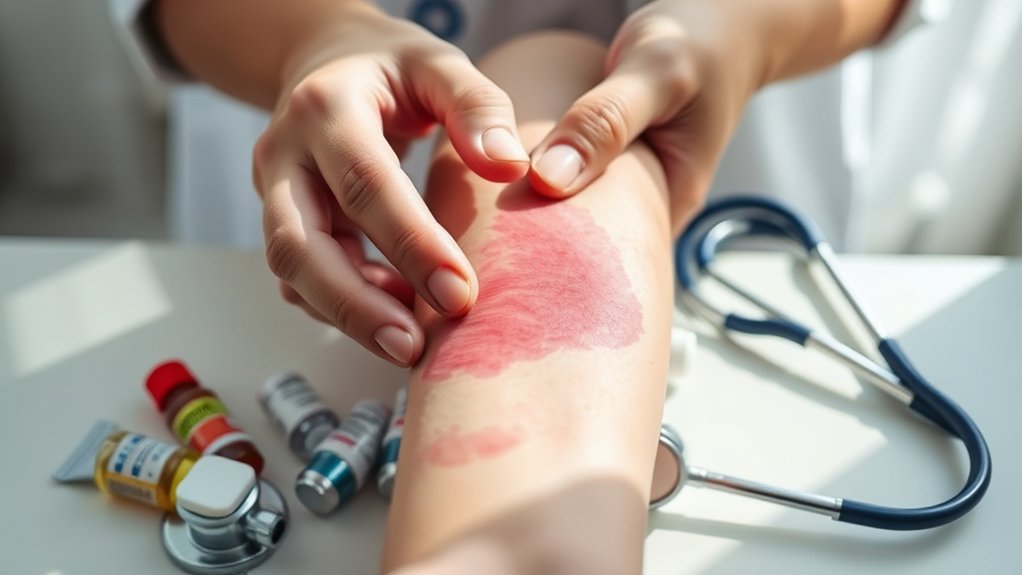When it comes to rash identification, knowing what to do and what to avoid is essential for accurate assessment. You should gather detailed patient history and observe rash characteristics closely. On the other hand, don’t overlook accompanying symptoms or rely solely on visual cues. Each rash can signal different underlying conditions. Understanding these nuances can make all the difference in diagnosis and treatment. What’s the next step in ensuring effective assessment?
Understanding Common Rash Types
Rashes can manifest in various forms, each indicating different underlying conditions.
Rashes present in diverse forms, each reflecting unique underlying health issues that require careful assessment.
You might encounter contact dermatitis, which arises from skin exposure to irritants or allergens, presenting as red, itchy patches.
Eczema, or atopic dermatitis, often appears as dry, inflamed skin, frequently seen in children.
Psoriasis, characterized by thick, scaly plaques, usually affects areas like the elbows and knees and may indicate an autoimmune response.
Fungal infections, such as ringworm, appear as ring-shaped, red patches with clear centers.
Viral rashes, including those from chickenpox or measles, often feature distinct patterns and can accompany systemic symptoms.
Recognizing these common types enables you to better assess skin conditions and seek appropriate treatment when necessary.
Key Do’s for Accurate Rash Assessment
When evaluating a rash, accurate assessment is essential for determining the appropriate course of action.
Begin by gathering a detailed patient history, including onset, duration, and any associated symptoms. Observe the rash’s characteristics such as size, shape, color, and distribution. Document any changes over time, as this can indicate progression or resolution.
Assess for systemic symptoms like fever or joint pain, which may suggest a more serious condition. Always consider potential triggers, including medications, allergens, or infections.
Employ dermatoscopic examination if necessary to enhance visualization of skin structures. Finally, consult relevant clinical guidelines or dermatological resources to aid in differential diagnosis.
This thorough approach guarantees a precise evaluation and informs effective management strategies.
Common Don’ts to Avoid When Evaluating Rashes
While evaluating a rash, it’s important to avoid making assumptions based on incomplete information. Missteps can lead to incorrect conclusions and unnecessary anxiety.
Here are some common don’ts to keep in mind:
- Don’t ignore patient history: Previous medical conditions or allergies can provide vital context.
- Don’t rely solely on visual appearance: Rashes can look similar but have vastly different causes.
- Don’t self-diagnose: It’s tempting to search online, but this can lead to misinformation and panic.
- Don’t overlook accompanying symptoms: Fever, itching, or pain may indicate a more serious issue that needs attention.
When to Seek Professional Help
How can you determine if a rash warrants professional evaluation? If the rash persists beyond two weeks, you should seek medical advice.
Additionally, if you experience symptoms like fever, swelling, or difficulty breathing alongside the rash, immediate evaluation is essential.
If the rash appears infected—characterized by increased redness, warmth, or drainage—contact a healthcare professional.
Pay attention to any unusual patterns or changes in the rash’s appearance, such as blistering or scaling.
Rashes associated with recent antibiotic use or new medications also require assessment.
Finally, if you have underlying conditions like eczema or psoriasis, consult your doctor for tailored guidance.
Early intervention can prevent complications and promote effective treatment.
Tips for Effective Communication With Healthcare Providers
Effective communication with healthcare providers is essential for accurate diagnosis and successful treatment. To guarantee you convey your concerns effectively, consider the following tips:
Effective communication with your healthcare provider is key to achieving an accurate diagnosis and effective treatment.
- Be Prepared: Write down your symptoms, their duration, and any triggers before your appointment.
- Ask Questions: Don’t hesitate to seek clarification on terms or treatment plans you don’t understand.
- Share Relevant History: Inform your provider about any previous rashes, allergies, or medications to provide context.
- Follow Up: If you don’t see improvement or notice new symptoms, communicate this promptly to your provider for further evaluation.
Frequently Asked Questions
Can Home Remedies Help With Rash Treatment?
Yes, home remedies can help alleviate rash symptoms. You might try applying soothing agents like aloe vera or oatmeal. However, it’s crucial to monitor the rash’s response and consult a healthcare professional if it worsens.
Are Rashes Contagious?
Rashes themselves aren’t contagious, but the underlying conditions causing them, like infections or allergies, might be. Always consult a healthcare professional to determine the specific cause and assess any potential risk of contagion.
What Causes Rashes in Children Versus Adults?
Rashes in children often stem from infections or allergies, while adults frequently experience rashes due to irritants, medications, or underlying conditions. Understanding these differences helps you identify appropriate treatments and manage symptoms effectively.
How Long Does a Typical Rash Last?
A typical rash lasts anywhere from a few days to two weeks. Factors like the underlying cause, treatment, and individual skin sensitivity can influence duration, so monitoring symptoms closely is essential for effective management.
Can Stress Trigger Skin Rashes?
Yes, stress can trigger skin rashes. When you’re stressed, your body releases hormones that may cause inflammation, leading to conditions like eczema or psoriasis. Managing stress effectively can help reduce these skin reactions over time.
Conclusion
In summary, accurately identifying rashes requires a careful approach, much like piecing together a puzzle. By following the essential do’s and avoiding common don’ts, you can enhance your assessment and guarantee nothing important is overlooked. Remember, if the rash persists or worsens, seeking professional help is vital. Clear communication with healthcare providers can greatly improve your understanding and treatment outcomes, helping you navigate the complexities of skin conditions with confidence.
